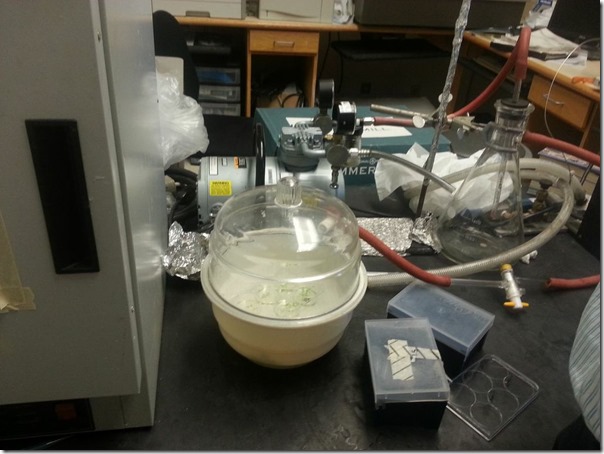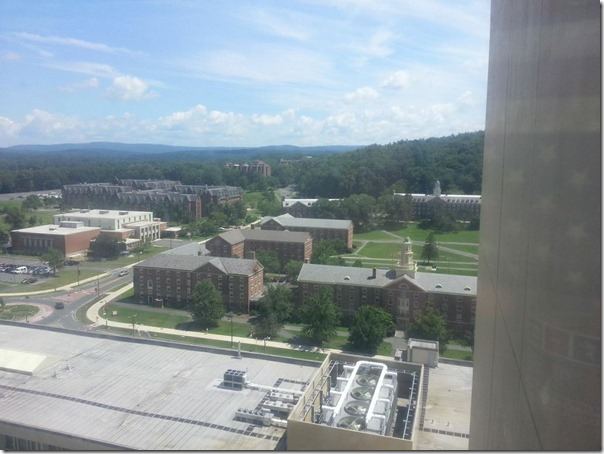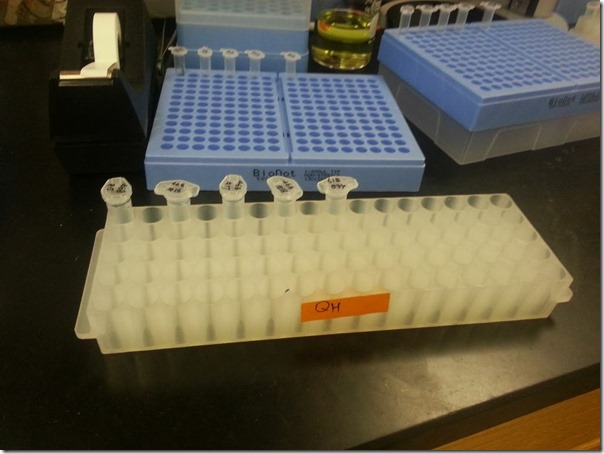View from 11th floor, Lederle Graduate Research Center
Day 7 of working in Dr. Alice Cheung’s laboratory started with us setting up a GUS assay. GUS is a gene that we put in to visualize where something is being expressed. In our case, we were using the plates we set up on 7/2, put in the 4 degree Celsius refrigerator for 2 days, and left in a 22 degree growth chamber for a little over a week.
GUS assay, different genes (labeled)
To set up our GUS assay, we had to make a solution of x-glucose. This will bind where GUS is being expressed, causing a blue color to happen. The blue will continue to accumulate in the areas where the GUS gene is expressed until the reaction is stopped with ethanol. We started by making the solution, adding it to a Petri container, and vacuuming the air out. Vacuuming the air out allowed more penetration of the solution containing the x-glucose, because air tends to accumulate on the edges of the plant.
Vacuuming out GUS assay for better infiltration
We then started learning the process for PCR- polymerase chain reaction. PCR is used to amplify a gene that you are trying to study. In our case, it has to do with the mutant lines of plants we are studying. First, you use a grinder to mash up the leaf and break open some of the cells. Then, we added some extraction buffer to help extract some of the DNA. We spun our tubes for 7 minutes, and then transferred the supernatant to a new tube. We had to take care and not add any of the solids still left, as that would interfere with the results of the PCR. We then added isopropanol, spun down the solution for 5 minutes, and were left with a supernatant to get rid of. Our DNA was stuck to the bottom of our solution, so we washed whatever else was in there away with 70% ethanol.
Eppendorf Tubes getting ready for PCR
We had to resuspend our DNA in EDTA, which is a chemical that helps our reaction. Using the vortex, we resuspended the DNA, and put it in a new microfuge tube. Finally, after We followed the directions and set up our PCR. We had to wait 2.5 hours for the reaction to occur. The PCR machine was full, so we wouldn’t be able to run the gels today.
Next, Norice and I started to think about the upcoming academic year, and how we could incorporate this into our classrooms. I started to lay out a plan, and create a plants unit that teaches most of this plant anatomy. It’s a real shame that both the Massachusetts Science and Technology Standards (2006, latest revision), and the Next Generation Science Standards (2013), do not focus enough on plants- the basis for all food on Earth.
Finally, we were able to check our GUS assay, and see how it would be illuminated. The roots in our of our samples RK8p:GUS were blue, which was very interesting to see. We will have to check the rest of the samples tomorrow and see how they turn out.


